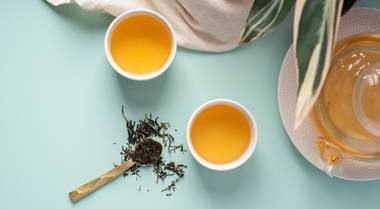Jasmine Teas: Everything From Green to Black to Pearls to Blooming
by Janelle Wazorick
April 23, 2024


Lets Talk About the Jasmine Flower
When you measure out a teaspoon of Jasmine Tea leaves for your teapot, you will often not see any flowers in the leaves, unless you're brewing Black Jasmine Song, which includes actual flower petals. Despite this, the floral scent and flavor are intensely present, having been absorbed into the tea leaves due to their natural odor-absorbing properties. But what exactly are jasmine flowers?Jasmine is a small, white flower that grows on vines in tropical or temperate climates across Europe, Asia, Africa, and Oceania. There are over 200 varieties, but Jasminum officinale and Jasminum sambac are the two primarily used in jasmine tea production.
Jasminum Officinale
Also known as Common Jasmine, Jasminum officinale, thrives in temperate climates. This flower has been so revered that its origins remain somewhat mysterious, though it is believed to have originated in Central Asia. Today, it is cultivated across Central Asia, China, the West Indies, and Europe. The flower's scent peaks during the summer months and is often harvested at night when its fragrance is most potent. Beyond tea, Common Jasmine is also favored by the perfume industry for its strong, sweet scent.
Jasminum Sambac
Known as Arabian Jasmine, Mogra in India, or Sampaguita in the Philippines, Jasminum sambac is a tropical jasmine variety grown widely across Asia, Africa, and the Americas. Unlike Jasminum officinale, Sambac flowers are larger, often described as double flowers. Like its counterpart, it is typically harvested in the summer. Although it is a popular choice for Chinese jasmine tea, it also finds uses in perfumes, religious rituals in Buddhism and Hinduism, and as decoration.
The Tea About Jasmine
Now that you know about the flower, let's discuss the teas used to make jasmine tea. Designers of jasmine tea blends often use green, white, oolong, and sometimes black teas. However, green and white teas are most popular as their mild flavors do not overpower the delicate aroma and flavor of the jasmine flower.The Chinese city of Fuzhou, the capital of Fujian province, is renowned for producing some of the finest jasmine tea in the world, a tradition dating back to the Song Dynasty. With a nearby river and mountainous terrain, Fuzhou is an ideal place for cultivating both jasmine and tea, making it unique in that it grows its own tea and jasmine for jasmine tea, perfecting a truly local craft.
Best Way to Prepare Jasmine Tea
As with any tea, the correct water temperature and brewing time are crucial for crafting the perfect cup. When brewing jasmine tea, follow the guidelines for the type of tea used in your blend. For instance, boiling water and a 3-5 minute brew time are suitable for black jasmine tea but would result in a bitter, astringent cup if used for green jasmine tea. Conversely, using 175°F water and brewing for 2-3 minutes suits green jasmine tea but would leave black jasmine tea bland, trapping rich flavors in the leaves.Black -212°F - 3-5 minutes
Green - 175°F-180°F - 2-3 minutes
White - 180°F - 3-5 minutes
Oolong - 180°F-200°F - 3-4 minutes
Jasmine tea can be brewed in almost any tea vessel, from a mug with an infuser to a teapot for multiple cups. Generally, use one teaspoon of tea leaves per cup. For a traditional experience, consider using a Gaiwan. While some prefer to add milk to black jasmine tea, it's best to enjoy jasmine teas without any additives to fully appreciate the unadulterated flavors of the tea and jasmine.
Try Jasmine Tea
Black Jasmine SongJasmine Phoenix Pearls
Jasmine Chun Hao
Jasmine Yin Hao
Jasmine Silver Needle
Jasmine Blooming Tea
Bi Tan Piao Xue (Snow Drop Jasmine) Delicate
Bi Tan Piao Xue (Snow Drop Jasmine) Strong